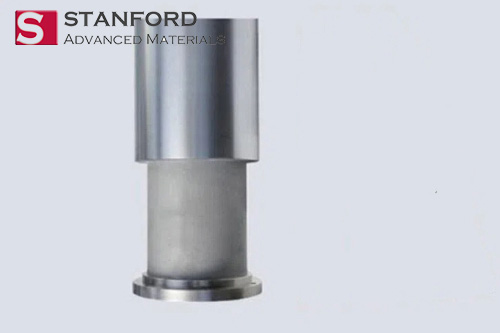In thin film technology, materials need more than just potential—they need consistency, resilience, and performance under pressure. That’s where molybdenum shines. Molybdenum sputtering targets, whether derived from pure metal or alloys, inherit the best of their base: high strength, excellent corrosion resistance, and superior thermal and electrical conductivity. These qualities make molybdenum a trusted material across industries like aerospace, semiconductors, solar energy, and electronics.
Classification by Shape of Molybdenum Target
In the sputtering target industry, target shapes are generally categorized into two main types: planar targets and rotary targets.
- Molybdenum Planar targets—including square, circular (disc), and plate targets—feature a flat geometry and are typically mounted parallel to the substrate. These are the most widely used target forms in research and commercial sputtering systems.
- Molybdenum Rotary targets, also known as cylindrical or tube targets, are tubular and rotate during sputtering. This motion increases material utilization and promotes better film uniformity, especially in large-area coating systems.
Here’s a closer look at the specific molybdenum target shapes commonly used:
Square Targets
Defined by their high melting point, superior electrical conductivity, and corrosion resistance, molybdenum square targets are the most common planar form. Their compact size and consistent erosion profile make them ideal for modular sputtering systems and pilot-scale production.
Disc Targets
Circular molybdenum targets are popular for their symmetry and uniform material distribution during deposition. These are a staple in magnetron sputtering, particularly in the production of microelectronic devices and thin film coatings for sensors or memory storage.
Plate Targets
Molybdenum plate targets are generally thicker—typically ranging from 5 mm to 25 mm—and offer greater material volume for extended sputtering runs. Their bright metallic luster reflects material purity and density. Custom dimensions are often produced to match unique chamber geometries or experimental setups.
Cylindrical Targets
These rotatable molybdenum targets are designed for large-scale, continuous sputtering systems. Equipped with internal magnets, they generate stable electromagnetic fields that ensure efficient sputtering rates and uniform coating thicknesses. Cylindrical targets are especially favored in the production of solar panels, large displays, and architectural glass.
Tube Targets
Hollow in structure and engineered with tight tolerances, molybdenum tube targets are typically produced with lengths up to 2000 mm, diameters around 100 mm, and wall thicknesses between 3 mm and 10 mm. Their precise flatness and controlled geometry make them ideal for optical coatings and advanced industrial PVD systems.
Classification by Application of Molybdenum Target
Molybdenum isn’t just another metal—it’s a problem-solver in environments where heat, corrosion, and precision all collide. Thanks to its unique blend of thermal stability, conductivity, and mechanical strength, molybdenum targets serve critical roles in several high-performance industries:
Semiconductor Applications
Molybdenum targets are widely used to deposit thin films for gate electrodes, contact layers, and diffusion barriers in integrated circuits and MEMS devices. Their ability to maintain structural and electrical stability at nanoscale thicknesses is crucial in advanced node semiconductor manufacturing.
Solar Cell Applications
In CIGS (Copper Indium Gallium Selenide) solar cells, molybdenum thin films act as the back electrode, providing both excellent adhesion and conductivity while withstanding high-temperature selenization processes. It’s a quiet hero behind the push for more efficient and durable thin-film solar panels.
Flat Panel Display Applications
From LCDs to OLEDs, molybdenum is used to form thin film electrodes and interconnects. Its low resistivity and smooth morphology help improve display resolution and performance. As screens get thinner and pixels get smaller, molybdenum keeps things sharp and reliable.
X-ray Imaging Targets
In medical diagnostics, molybdenum targets are used to produce soft X-rays ideal for mammography. The radiation they emit provides better contrast with lower doses, making them essential for safer, more accurate breast cancer screening.
Optical and Infrared Coatings
Molybdenum’s reflective and absorptive properties make it suitable for specialized optical coatings, including mirrors, filters, and IR sensors. Its thermal durability ensures long-term performance even under intense light or heat exposure.
Protective and Functional Coatings
Used in wear-resistant and corrosion-resistant coatings, molybdenum targets are applied in aerospace and industrial components where parts are exposed to friction, heat, or chemically aggressive environments. These films add life and reliability to critical hardware.
Conclusion
Choosing the right molybdenum target—both in shape and application—is more than a technical formality; it’s a key step in achieving consistent, high-performance thin film results. Whether you’re optimizing semiconductor device yields, increasing solar cell efficiency, or producing uniform coatings for advanced displays, understanding how molybdenum targets function and where they excel helps engineers and manufacturers make smarter, future-proof decisions.
At Stanford Advanced Materials, we specialize in delivering high-purity molybdenum sputtering targets tailored to the precise demands of modern industries. With years of experience, rigorous quality control, and a deep understanding of thin film technologies, SAM is your trusted partner for materials that perform when it matters most.
From lab-scale development to full-scale production, SAM provides the materials that move innovation forward, layer by layer.





